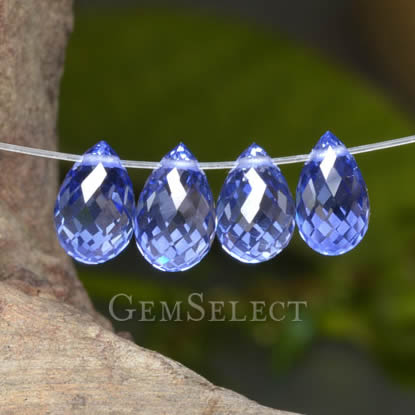History of Gemstone Briolettes
Most faceted gemstones today are cut with a flat table and crown and pavilion facets. It's a style that maximizes the light returned to the eye and thus the brilliance of the gem. But at one time this was not the most popular faceting style. Back in the 17th century the briolette was the favorite of royalty and aristocrats. A fine example is a diamond necklace that Napoleon presented to Empress Marie Louise containing 10 diamond briolettes weighing over 4 carats each. The necklace is now in the Smithsonian Institution in Washington DC. Browse all our briolette cut gemstones for sale.

The briolette is a gemstone shaped like a pear or drop, featuring long triangular facets covering its entire surface. Historians trace the origins of the briolette cut back to India around 800 years ago. The gemstone gained popularity in Europe thanks to the renowned French traveler and trader, Jean-Baptiste Tavernier, who introduced briolettes from India.
The popularity of the briolette started to decline in the late 17th century as gem cutting technology progressed and the early versions of the modern round, brilliant cut became popular. Many existing briolettes were in fact recut using modern methods.
The briolette cut regained popularity in the Victorian and Edwardian eras and was a favorite of Art Deco designers. However, briolettes soon faded into obscurity once again. In large part is was a cost issue. A briolette has a lot of surface area and requires large pieces of rough stone. It is quite expensive to cut diamonds, rubies or sapphires as briolettes, and gem cutters regard briolettes as an inefficient use of the rough material. Only recently have briolettes started to be seen again, particularly in the form of less expensive gemstone materials.

While it is true that briolettes do not concentrate brilliance like a modern round brilliant cut, briolettes have their own charm. They display color and reflect light from any angle, and have a quiet, refined elegance. They work especially well as earrings and pendants because they dangle and move, allowing them to catch the light. They are generally unencumbered by any setting except at the top, and this allows more of the gemstone to be visible than with any other cut.
When you buy loose briolettes you will often find that they come with a hole drilled through the top. Usually they are are cross-drilled, where a hole is drilled through the gem near the tip. This allows the gem to swing freely on a wire or pin and avoids the use of adhesives. Sometimes you will find briolettes top-drilled, where a hole is drilled a few millimeters into the gem from the top, allowing a small metal pin to be inserted. A third method is to abrade a small area at the tip, providing a slightly pitted surface in order for an epoxy resin to be used to secure a metal cap.

